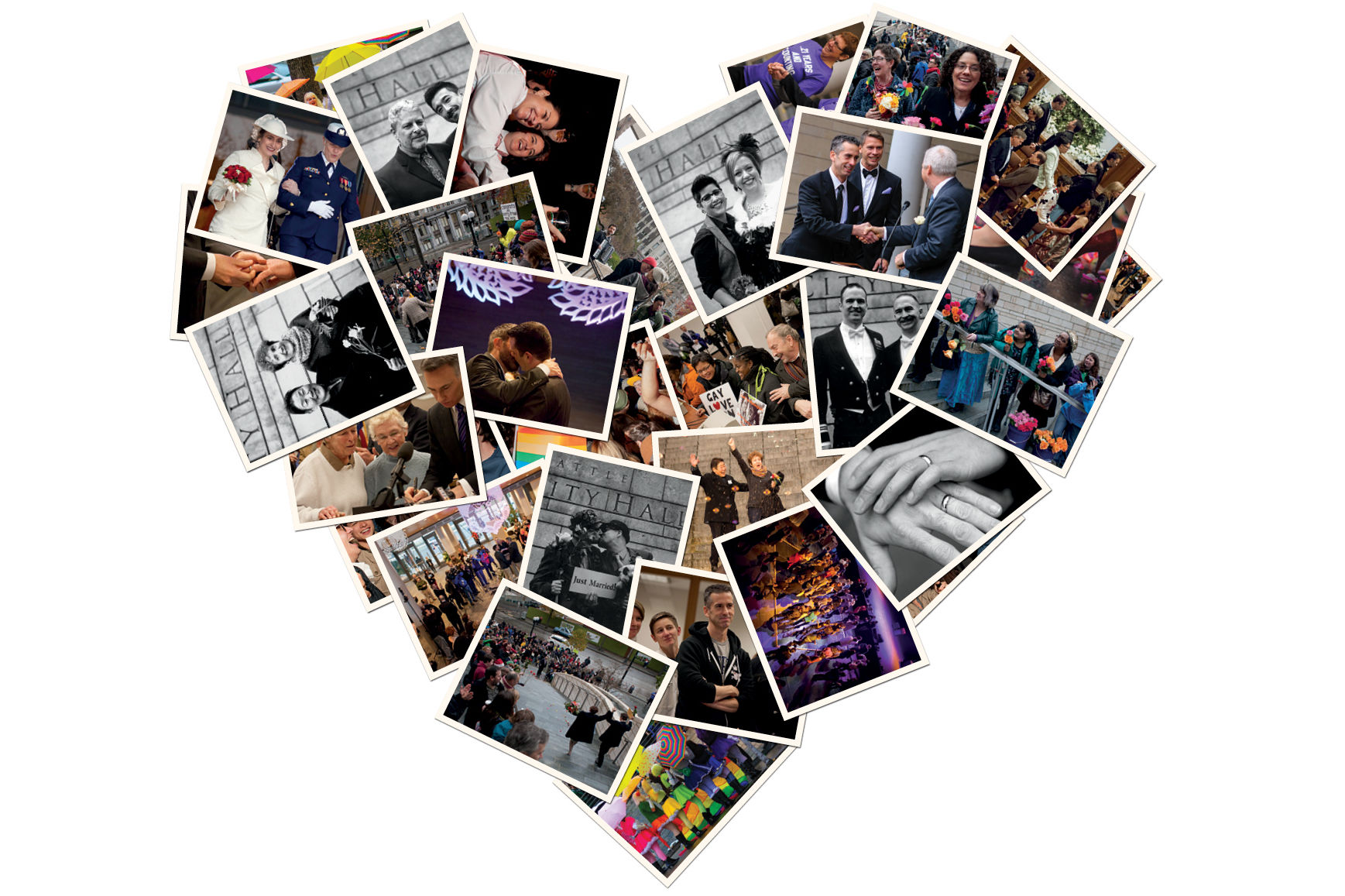
The Day City Hall Became a Same-Sex Marriage Cathedral
Photographs by David Ryder, Robert Fisher, and Michael Holden
A wedding planner would’ve scoffed. One hundred forty or so couples, in one day, with a municipal building for a venue, and only weeks to plan? Hard pass. But for a sex columnist and a mayor? Not a problem, apparently. When The Stranger’s Dan Savage dialed Mike McGinn a decade ago to see if he could help put on a marathon day of nuptials at Seattle City Hall, the mayor didn’t hesitate to lend his support.
The call set in motion perhaps the most joyous assembly in the building’s history. On December 9, 2012, scores of partners flocked to 600 Fourth Avenue to make it official following the state’s legalization of same-sex marriage—two and a half years before the U.S. Supreme Court’s landmark ruling. Several other sites across Seattle also hosted weddings that day. But none were as ambitious in scale or as symbolic as the proceedings at city hall. Photos of couples descending the building’s many steps to cheering masses were shared around the world.
It came together in a whirlwind. While governor Christine Gregoire signed marriage equality into state law in February of 2012, a petition from opponents meant voters wouldn’t decide the fate of gay marriage until that November. Referendum 74 passed, but not by an overwhelming margin—54 percent voted in favor. Still, it made Washington just the seventh state to legalize gay marriage, and only the third to do so by popular vote. The new law would take effect on December 6, with the first weddings held after a mandatory three-day, post-license waiting period.
With just a few weeks to coordinate, the mayor’s chief of staff, Julie McCoy, headed up organizing what could have been a logistical nightmare. Savage, meanwhile, started recruiting volunteers and soliciting donations for materials. “I have this crazy idea that we should decorate city hall,” he said in a fundraising video. “It’s a beautiful and gorgeous space, but it’s not very intimate.”
A friend of Savage, Jennifer Zeyl, would warm the place up. The longtime set designer and current Intiman Theatre artistic director rounded up volunteers to transform a shiny but cavernous government building into a romantic setting. Imagination and suspended disbelief are prerequisites for a life built around stages. “What I do,” she says, “is absolutely unheard of shit.”
Zeyl led the design of six “chapels” on multiple floors. Each had a silver woodgrain podium—a “lectern meets hitching post”—fabricated for the occasion. Steve Coulter, then ACT Theatre’s technical director, let the city borrow some raised platforms. Carpet to Go donated rugs. Flowers on 15th handled all arrangements for free. Celeste Cooning’s drop banners, cut on Tyvek and illuminated by Monty Taylor’s rainbow LED lights, served as ornate backdrops for each setup.
A handful at a time, couples new and old—Dan Savage and partner Terry Miller among them—would approach the chapels with small wedding parties. Local judges did the honors. Then the newlyweds would wait by west-facing glass doors for McGinn and others to announce their names as they exited.
Under a classically gray Seattle sky, these trips down the stairs were similar—met with wild cheers, a little accordion, and, sometimes, a rice shower. But the journeys to and from that red carpet–like scene were more different than they appeared in all those well-traveled snapshots.
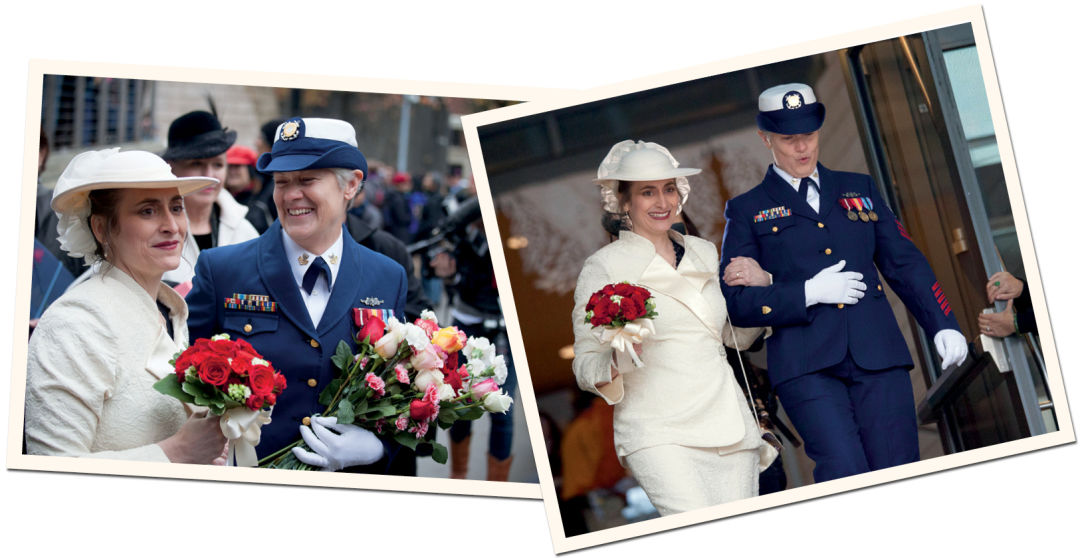
“I was like, I have a wedding gown. You are not getting married in your Class Bs.”
Image: David Ryder
Deb Needham and Nancy Monahan
The uniform captured Deb Needham’s attention first. At a coffeehouse haunt for lesbians down in Portland, a woman with salt-and-pepper hair wore her Coast Guard blues. Bold, Deb thought. It was the late 1990s. “Don’t Ask, Don’t Tell” hadn’t been repealed yet.
Nancy Monahan wasn’t as romantically audacious as her outfit choice might suggest. She noticed Deb’s hair, cut and bouncy, and the snappy professional attire the government worker fresh out of college would wear around the cafe. But she wasn’t about to make the first move.
So Deb “set a trap,” she says. It was around the holidays. Catching a glimpse of Nancy’s pickup truck outside, Deb asked if she could help haul a Christmas tree. How could she turn that down?
A fireside chat afterward led to a discovery of shared dreams and, soon, a shared life together. They had to keep their relationship mostly hush-hush the first year and a half, as Nancy wrapped up her military career. But by the spring of 2004, the couple was married. In Multnomah County, same-sex marriage licenses were suddenly available after four county commissioners went rogue. But Oregon voters soon amended the state constitution to limit marriage to “between one man and one woman.” In April 2005, Oregon’s supreme court erased roughly 3,000 same-sex marriages, including Deb and Nancy’s.
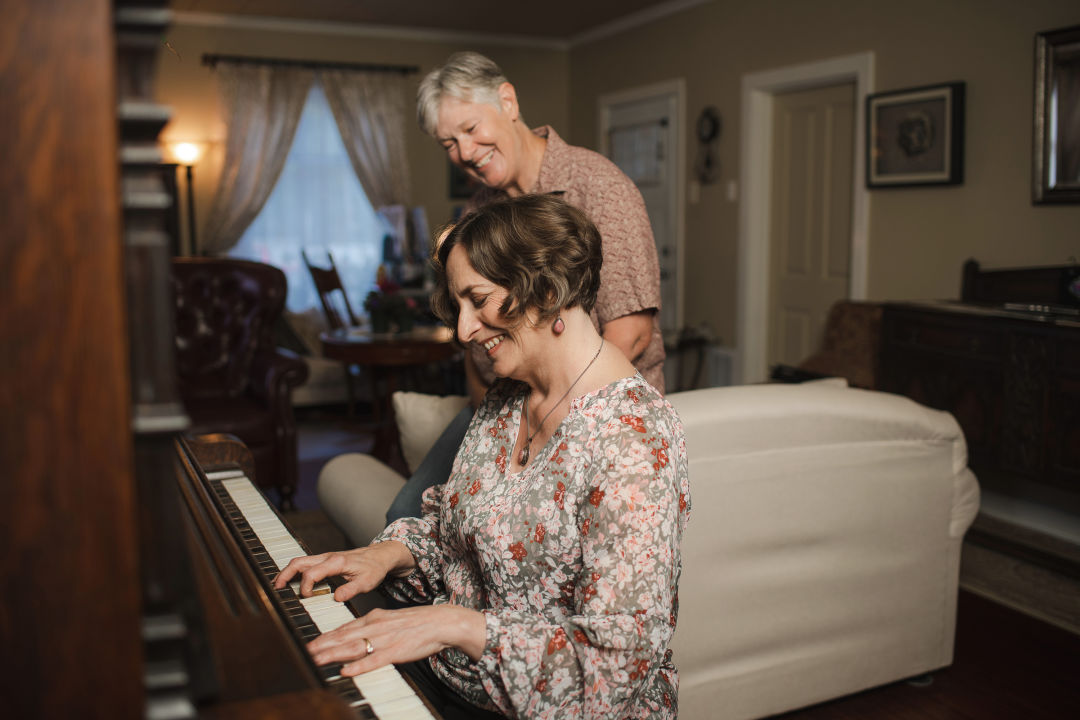
Deb and Nancy in their Renton home.
Image: Daniel Berman
In between, the couple received a harsh reminder about the practical importance of such unions. Three weeks after their wedding, Nancy was hit by a car and taken to a hospital in Washington, where the couple owned a sylvan 10-acre parcel. Deb couldn’t see her at first. She told workers there that she had power of attorney, that they were married in Oregon. But their legal rights were basically zilch in their home state. “They said, ‘You’re just a friend here.’”
The incident awakened the activist in both of them. They moved to Renton and spoke up for gay rights as Washington slowly granted them—first by legalizing same-sex domestic partnerships, then by passing Referendum 74.
They were among the dozens of couples who lined up outside the King County Recorder’s Office on Fourth Avenue to nab licenses on December 6, 2012. On a damp, chilly night, “Chapel of Love” and other sing-alongs kept spirits high in the zigzagging queue. A record 489 licenses were doled out over 18-plus hours.
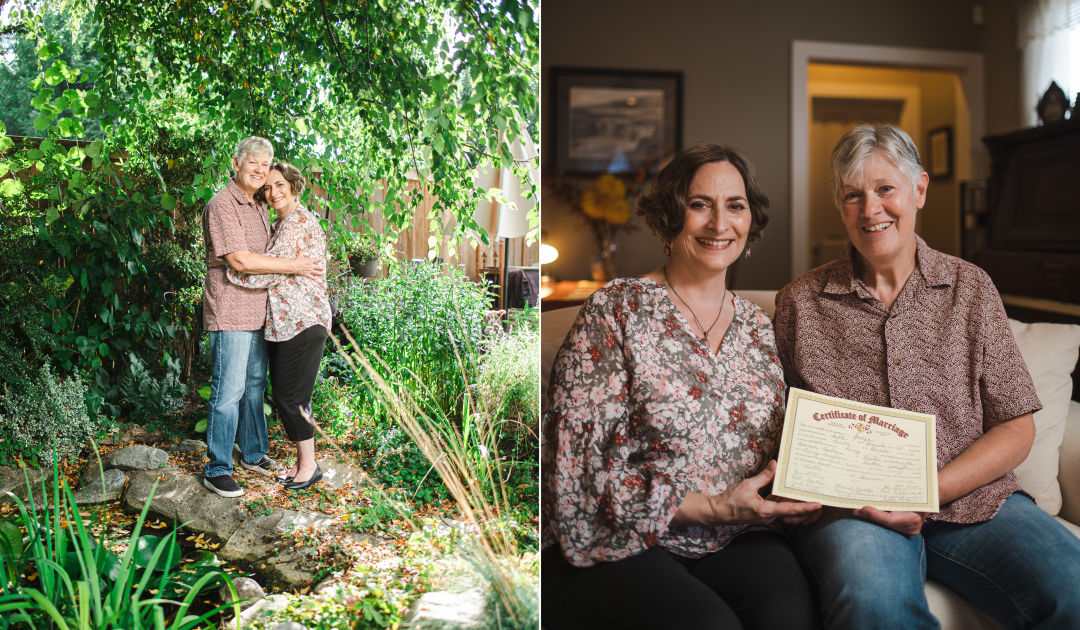
Image: Daniel Berman
Booking an appointment for a city hall ceremony on that Sunday—the first day same-sex couples were eligible to get married because of a mandatory marriage license waiting period—wasn’t a breeze either. Deb couldn’t find an opening, and Nancy didn’t want to go sans reservation. But the couple eventually agreed to risk it, arriving early. Deb encouraged Nancy, with some help from Nancy’s father, to wear her fanciest military garb. “I was like, I have a wedding gown. You are not getting married in your Class Bs.”
Journalists ate it up. After the couple managed to find an open slot and tie the knot, a throng of photographers from Getty Images, the Associated Press, and other outlets captured them walking arm in arm, Deb in all ivory, Nancy in decorated blue regalia (the couple would later have to pay for all but one of these photos, Deb notes).
As a veteran and a lesbian, Nancy felt a sense of pride publicly wedding these two aspects of her identity that day. Just one year earlier, the government had lifted the “Don’t Ask, Don’t Tell” ban on gay and lesbian service members. Nancy felt its oppression firsthand in the military, especially after a respite between her time in the Navy and Coast Guard. “You have to go into the pretend world again, because you’re not going to be accepted for who you are.”
The couple doesn’t have to worry about hiding now. Social security and retirement plans—Deb is an emergency management director—consume more of their thoughts. A picture of them all dressed up hangs in their living room.
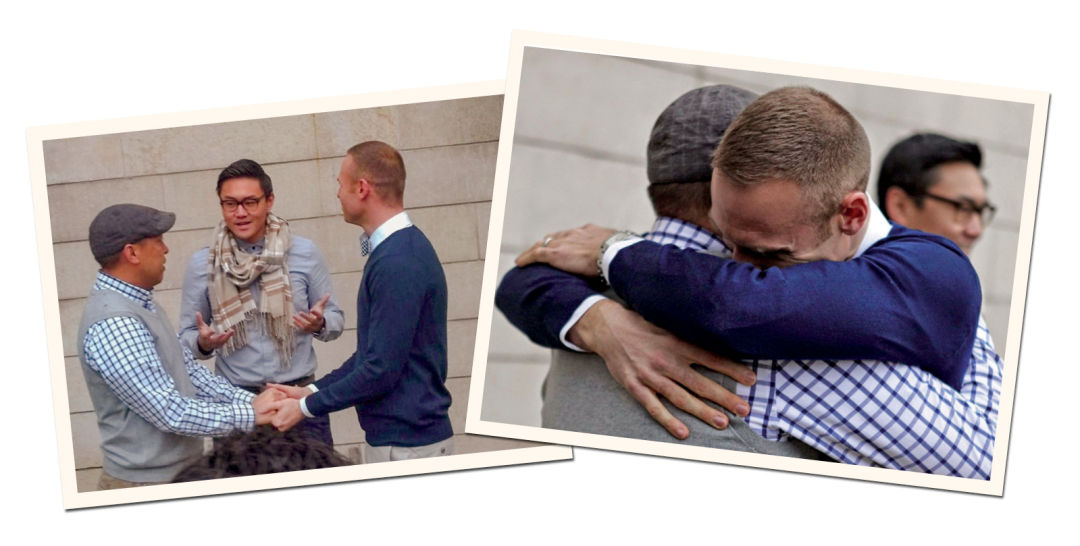
Bernie and Ryan made an impromptu return to the site of their engagement photos.
Ryan Hamachek and Bernie Liang
Ryan Hamachek and Bernie Liang have a photo from city hall hanging in their home, too. But the blown-up image is from a different day than all the other matrimonial ones.
Like many couples, Ryan and Bernie didn’t wait around for the legalization of same-sex marriage to pledge their love for one another at a commitment ceremony. So what if it wasn’t legally binding? They’d planned, gotten stressed, spent too much money, and, under the twinkle of SoDo Park’s towering, industrial ceilings in July of 2011, had an amazing time with friends and family. Spiritually, they’d had a wedding.
When they took engagement photos, including the one from city hall that currently resides in their Beacon Hill townhouse, they couldn’t have known they were just one year and some change shy of a legal union at the municipal building. “We didn’t think that was even going to be possible in our lifetimes,” says Bernie, who’s now the senior director of student engagement at Seattle University.
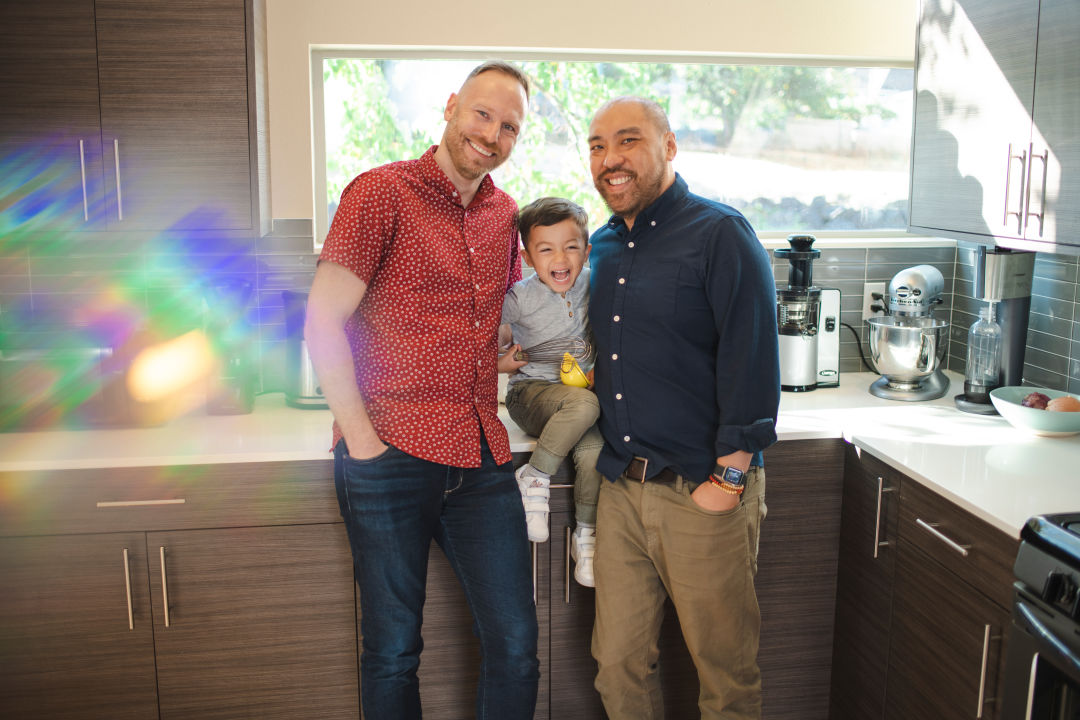
Ryan and Bernie hold their son, Eli, at their home in Beacon Hill.
Image: Daniel Berman
Neither regrets jumping the gun; Ryan says the commitment ceremony, with all their loved ones there, remains more meaningful to them than when they officially wedded. But the manager in global trade services at Amazon knew then that joining the festivities with so many other couples on December 9 would acquire its own resonance, and symbolism, with the passage of time. “I was like, I want to be able to look back and say we did this as soon as we were able to do this.”
Bernie, an introvert, took some convincing. All those simultaneous weddings—it would be a lot. But even without an appointment, the couple decided to return to the site of the engagement photos that, they remembered before heading over in an Uber, were in the guestbook signed by their loved ones at their commitment ceremony.
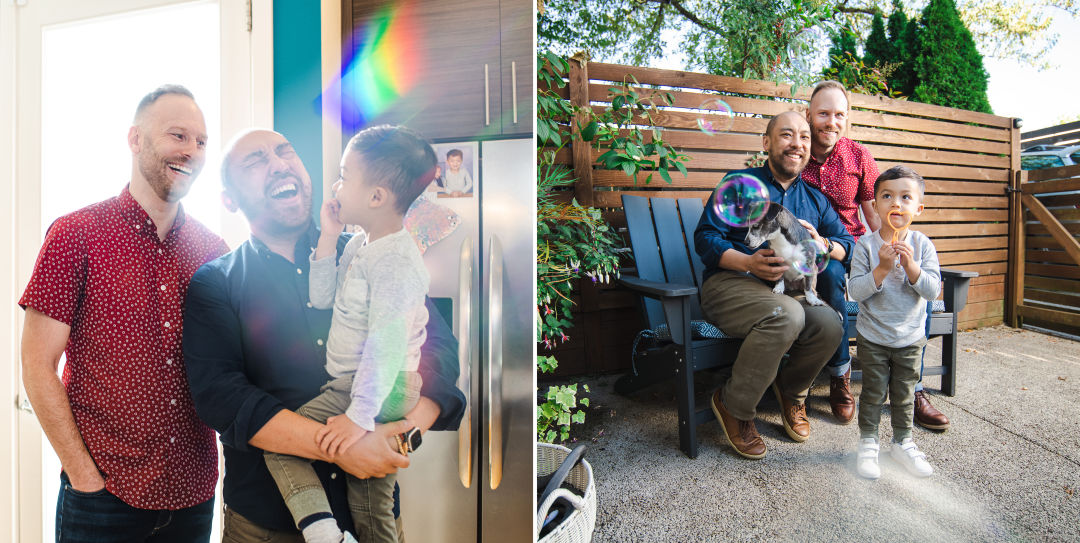
Image: Daniel Berman
More serendipity greeted them upon arrival: Photographers from their previous big day were circulating and willing to take some shots of them. Unable to snag a spot inside, the couple climbed to the top of the stairs, past all the onlookers and signs, and got married against the stone wall. Ryan sported a blue sweater and a bow tie; Bernie wore a newsboy cap and a gray vest.
Though they’d thrown this ceremony together last-minute, the couple’s legally recognized union gave them long-term comfort when it came to building a family. Having the same rights under marriage as straight couples “just put me at ease through the process of adoption,” says Bernie.
Their son, Eli, is now three years old.
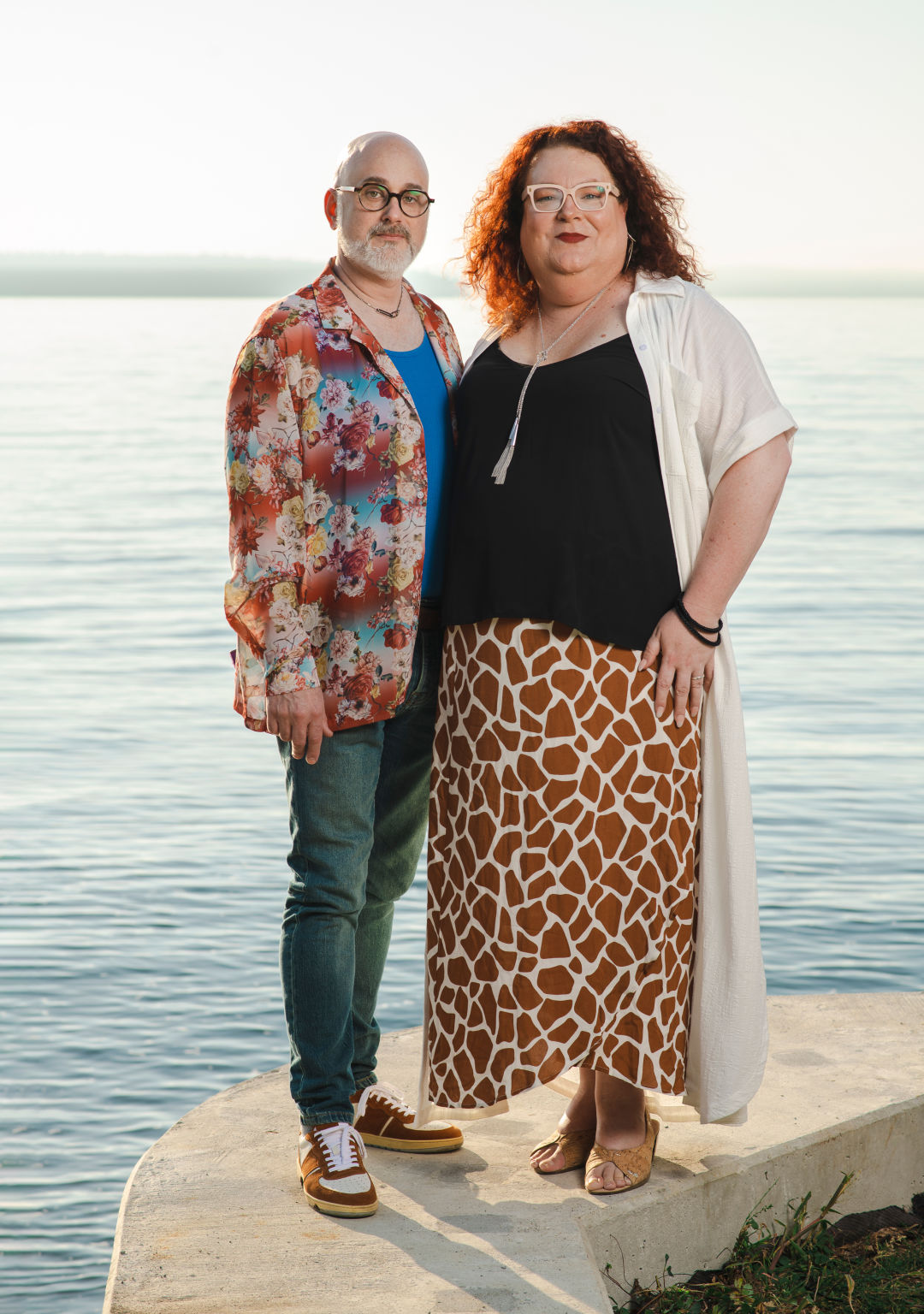
Jason and Shannon, both artists, immediately made note of city hall's new look, which included Celeste Cooning’s cut Tyvek sculptures.
Image: Daniel Berman
Jason Bowlsby and Shannon Roudhán
Among the many wedded couples still together 10 years after exiting city hall, perhaps none has undergone a greater change to their relationship, at least superficially, than Jason Bowlsby and Shannon Roudhán.
When the textile artists entered the building that December day to legally marry in kilts and Dr. Martens, they presented as the same gender. They’d been together for 18 years and had held their own unofficial same-sex ceremony long ago.
But when the coronavirus pandemic forced the West Seattle couple to stay home, Shannon decided she could finally lean all the way into a gender identity true to her essence. Transition, she says, “is a thing that you do your entire life.” She’d begun mulling a change long before she and Jason completed their nuptials. “I knew this even back then,” she says.
The spouses only started talking about it a few years ago, and Jason supported her when she transitioned shortly thereafter. “We’re still married,” the couple quips.
Together they’ve published 12 books on quilting, crocheting, and knitwear. Quarantining also allowed them to set up a home studio and offer an array of virtual art classes.
Upon arriving at city hall, Shannon immediately noted Celeste Cooning’s cut Tyvek sculptures. “The place was gorgeous.”
Jason also observed an uncommon unity among those in attendance. Every party has a curmudgeon usually, he says. This one didn’t. Though their love stories were different, the couples all grasped the gravity of the occasion. “Everyone felt the same thing.”
A Seattle Municipal Court judge conducted Bowlsby and Roudhán’s ceremony, his first ever—the couple couldn’t tell who was more excited, him or them. He asked for selfies. Mayor Mike McGinn complimented their kilts and announced their names as they set out.
Shannon resisted the urge to critique his politics. It was hot, she needed a drink, and “I just wanted to take off those damn shoes.”
For anyone with energy left, a party at the Paramount followed with a group first dance. Theme-appropriate tunes like “At Last” blasted into the night.
Ten years later, same-sex couples still face threats from the highest levels of government, as Clarence Thomas pushes the Supreme Court to “reconsider” the ruling that made same-sex marriage legal at the federal level. If that ever comes to pass, the matter, like abortion, will once again be left to the states. Washington’s current law would still hold.
On that cloudy Sunday in 2012, the masses gathered along rails and sidewalks made Seattle’s position clear on the matter. They shouted words of exultation tinged with, even in this forward-thinking city, a bit of embarrassment. “Congrats,” as one sign put it, “and sorry it took this long.”




